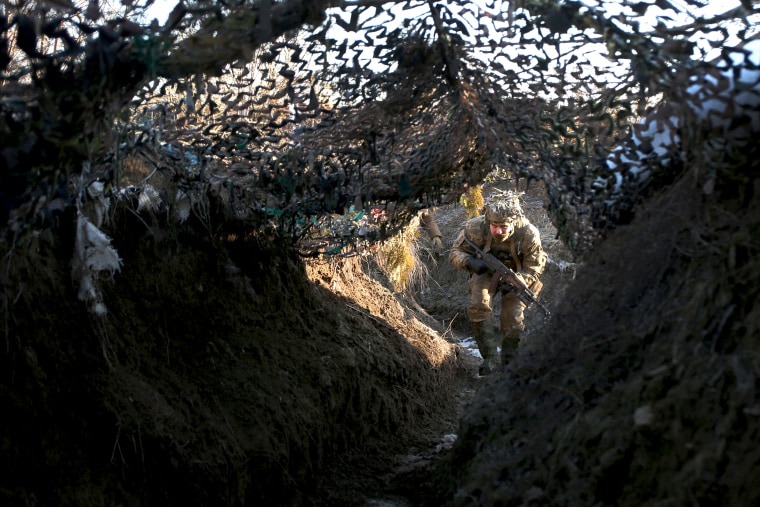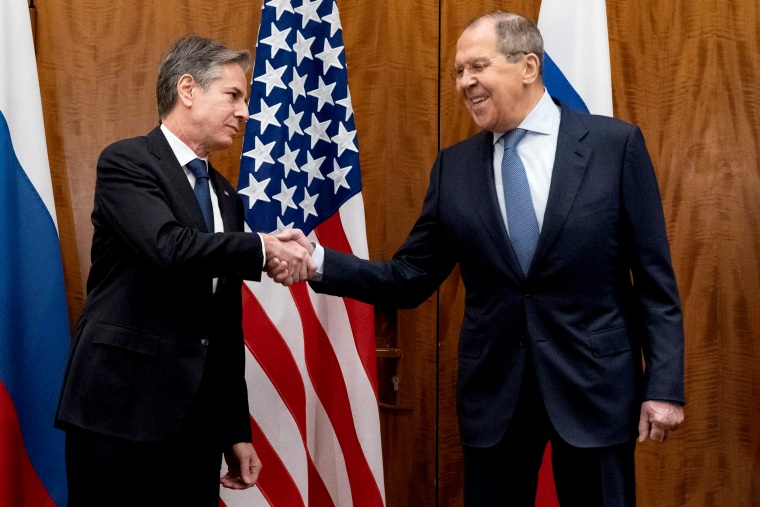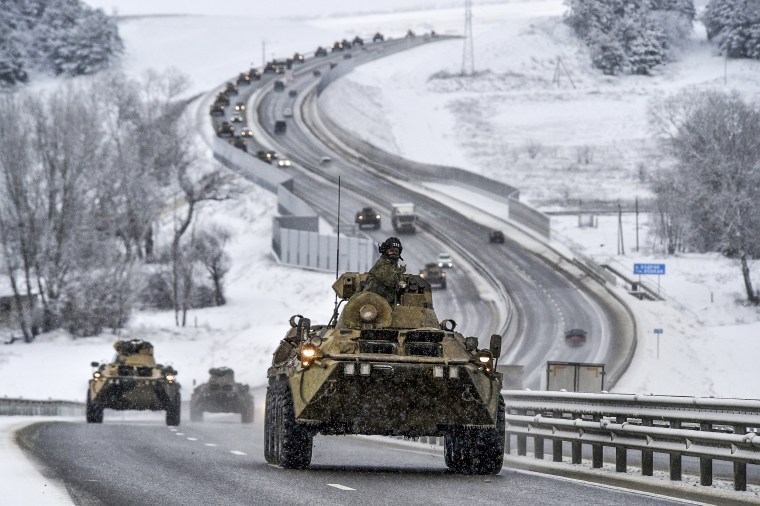Russian President Vladimir Putin has massed an estimated 100,000 troops on Ukraine’s border, with the United States and its European allies scrambling to deter an invasion and respond to the Kremlin’s demands.
Although Russia has denied it’s planning to attack the former Soviet state, Putin has issued several security demands that have been dismissed by the West, resulting in a diplomatic stalemate.
What will Putin’s next move be? The question has dominated conversation in the corridors of power in Europe and across the Atlantic as President Joe Biden looks to ward off what he said would be “the most consequential thing that’s happened in the world, in terms of war and peace, since World War II.”
NBC News looks at what Putin might want from the standoff, and how he could be planning to get it.
Why Ukraine?
Russia and Ukraine have been linked by a common history since the ninth century, when Kyiv became the capital of the ancient state of Rus.
In the early 20th century, the two nations and nearby Belarus formed the Slav core of the communist Soviet Union.
In addition, many Russians and Ukrainians share family ties and speak closely related languages.
The two neighbors stayed aligned after the breakup of the USSR in 1991, but began drifting apart in the 2000s as Kyiv sought deeper integration with Europe.
The relationship had completely soured by 2014, when months of deadly protests and the toppling of Ukraine’s pro-Russian government culminated in Moscow annexing Ukraine’s Crimean Peninsula. Russia also threw its weight behind a separatist insurgency in Ukraine’s east, a war that has rumbled on ever since despite a series of shaky cease-fires, costing an estimated 14,000 lives.
For years, Putin has been saying Russians and Ukrainians are so closely historically and culturally aligned that they are essentially one people.
He has also said that Ukraine as an independent country is an artificial construct, and lamented the breakup of the Soviet Union as “the greatest geopolitical catastrophe of the century.”
A former KGB officer, Putin has spent his time in office seeking to restore Russia’s position in the world. The increasing presence of NATO, established in the wake of World War II as a bulwark against the then-Soviet Union, in Eastern Europe and the West’s close ties with Ukraine have been at the crux of Russia’s demands in the Ukraine standoff.

What has Putin demanded?
The Kremlin’s official line amid the current standoff centers on Putin’s demands for security guarantees for Russia that would include a stop to NATO’s expansion eastward, and a formal veto on Ukraine from ever joining the military alliance. It also wants NATO to roll back its military deployments in the region. The demands would significantly redraw Europe’s security landscape and have been largely dismissed by Washington and the military alliance.
Putin’s statements on Ukraine’s history and statehood have given rise to a view among Russia observers that he sees Ukraine as “unfinished business” and wants to follow the seizure of Crimea with further action to bring the country back under Moscow’s influence, as he entertains an ambition to reconstitute a Moscow-led Eastern bloc reminiscent of Soviet times.
“He is personally, deeply and emotionally invested in recovering Russia’s former power over his neighbors,” said Keir Giles, a senior consulting fellow of the Russia and Eurasia Program at the London-based think tank Chatham House.
Seeing Ukraine slowly but surely drifting out of the Kremlin’s control and aligning with the West, Putin could be feeling that “the moment is right” to reassert his long-held claims to a greater extent of Russia’s power, Giles added.
Why now?
Since Kyiv’s pro-Russian government was toppled in 2014, Moscow has wanted to bring Ukraine back into its sphere of influence. But the current crisis also comes during heightened tensions between the Kremlin and the West, sparked by Washington’s accusations that Russia meddled in the 2016 presidential election, used chemical weapons to go after its enemies abroad, and intensified a crackdown on any form of dissent at home, including imprisoning the opposition leader Alexei Navalny.
Russia has grown in both capability and confidence, and the combination seems to have convinced Putin that he is in the best possible position to reassert his demands, Giles said.
Russia’s capabilities have grown as a result of a decadeslong program to reconstitute its military power, he added, and the Kremlin’s confidence has grown because of the consistent failure of the West and Western institutions to deter its geopolitical ambitions.
While some Western officials have questioned the Kremlin’s assertion that it’s threatened by NATO, there is no doubt Russia aspires to roll back security in Eastern Europe, and remove the U.S. and NATO as guarantors of security in the region, Giles said.
“Most public discussion of Russia’s demands has missed the point that what Russia is asking for is not security guarantees for itself, but the removal of security guarantees for much of Europe,” he added.
The end result would be a continent that is dominated by Russian military power and held at risk by Russian missiles, he added.
The growing number of Russian troops on the Ukrainian border and now in Belarus has been the “hypnotist’s watch” for the West, Giles said, accomplishing a Kremlin goal of “terrifying” the U.S. and its Western allies into opening negotiations with Russia on the future security of Europe — a topic that “ought to be off the table.”

Any domestic pressures?
Ukraine is just an “unfortunate victim and the most convenient place for Putin to mount his demands with menaces,” according to Giles.
His comments echoed those of Ukrainian lawmaker Oleksiy Honcharenko, who told Russia’s TV Rain on Saturday that Moscow was using Ukraine as a “pain point” to blackmail the West.
Putin’s motivation also could include a desire to shore up his base at home — a popular military victory as a way to distract from domestic problems.
His popularity among Russians spiked after the annexation of Crimea in 2014.
“Putin would, no doubt, be happy to be able to present a foreign policy victory over the West, whether it is real or illusory, in the run-up to his reanointment as president in 2024,” Giles said.
Putin could run for up to two more six-year terms once his current mandate expires, after a contentious legislative change in 2020.
Still, military action in Ukraine could be tricky to sell to the Russian public, especially if the standoff turns into a prolonged conflict. Secretary of State Antony Blinken appealed to that in a speech in Berlin last week, warning Russians about “a pointless war” with their neighbor and “young people who will risk or even give their lives to it.”
Maintaining tension over Ukraine also helps Putin reinforce his image of a resolute defender of Russia’s interests at home.
“He wants to elevate his own status and Russia’s status in the international area, and consolidate recognition of the exclusivity of Russia’s interests,” said Volodymyr Fesenko, a Kyiv-based political analyst and head of the Penta Center, think tank. “He wants people to feel afraid. That’s important to him.”
Will he or won’t he?
Experts and military analysts are divided on whether Putin intends to engage in a full-blown war with Ukraine. The U.S. and its allies say Russia has been massing forces around the east and south of Ukraine for months. The Russian Defense Ministry shared photos this month of its forces moving into Belarus as part of a joint military drill in February — increasing military presence near Ukraine’s northern border and heightening tensions.
A similar buildup, although on a smaller scale, unnerved the world last April, with Moscow amassing tens of thousands of troops near the Ukrainian border, but ordering a withdrawal after weeks of tensions.

Some experts say a full-scale invasion is possible, even likely. Biden himself made that assertion last week, saying he thinks Putin “will move in” and “has to do something.”
“The Russians put in place all of the capabilities and enablence that they would need to carry it out,” said Jack Watling, a land warfare expert and research fellow at the Royal United Services Institute, a think tank based in London. “They have a sufficient force ratio to be able to seize quite a lot of Ukrainian territory.”
It’s less likely Putin would want to assault Kyiv in this scenario, Watling said, as it could turn into a “very costly” and bloody fight should the Ukrainians have the morale to defend the capital.
If Putin does decide to invade, then Russian strikes to neutralize Ukraine’s air defenses are likely, he added.
“We are in a position where it comes down to the decisions and calculus of about four people in the Kremlin,” Watling said. “And not even the Russian ministers and ambassadors know what that decision will be.”
What else could he be planning?
Some experts, like Giles, see a full-blown war as the “most messy, expensive and, above all, unpredictable course of action that President Putin could trigger.”
Short of an invasion, he could place midrange missiles in Crimea and Belarus, ratcheting up the tensions, according to Fesenko.
There is also a concern the Kremlin could wage a cyberwar after Ukraine was hit with a massive attack that downed a number of government websites this month. Kyiv blamed the attack on Russia.
And if it wanted to go further, Fesenko said, the Kremlin could carry out “local” incursions in Ukraine, including the Donbass region in the country’s east, which is currently controlled by pro-Russian separatists, and Ukraine’s portion of the strategic Sea of Azov in the south, which Russia has been eyeing for years.
Ukrainian President Volodymyr Zelenskyy, who campaigned on a promise of ending the war with pro-Russian separatists in the east, has made little progress to resolve the conflict, and talks with Russian and European partners have stalled. Further irking the Kremlin, he has consistently shown his resolve for Ukraine to stay on a pro-European course.
With Zelenskyy’s popularity waning, a regime change in Kyiv would be “a far more reliable and less dangerous means of getting what Russia wants than rolling tanks across the border,” according to Giles.
Late Saturday, Britain’s Foreign Office accused Moscow of trying to accomplish just that, saying the Kremlin was working to install a pro-Russian leader in Ukraine. It declined to provide evidence to back its accusation, and the Russian Foreign Ministry had dismissed the claim as “disinformation.”
While some experts are skeptical about the British claim and its connection to the standoff, should Russia go ahead with a full-scale invasion, having pro-Russian political forces on the ground makes tactical sense, Watling said.
“If they need to take a maximalist approach, then they will need somebody to step in and govern the territories they seize,” he said.
